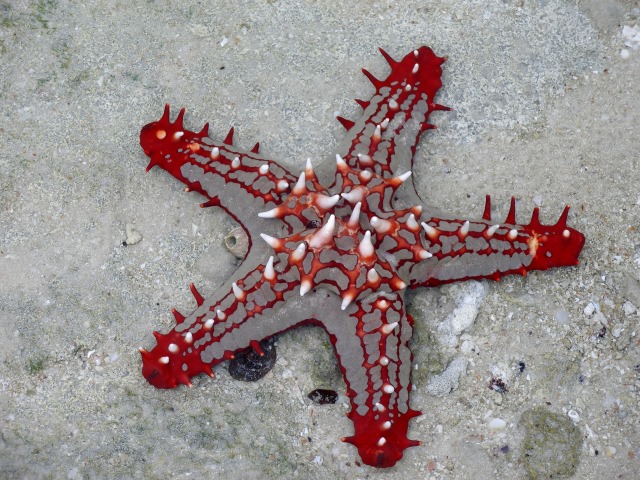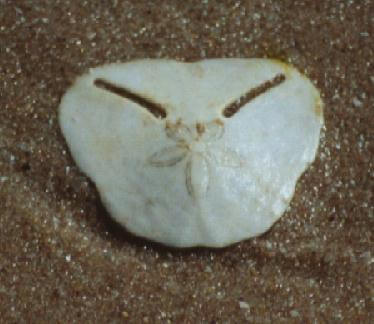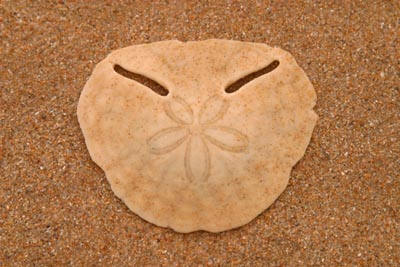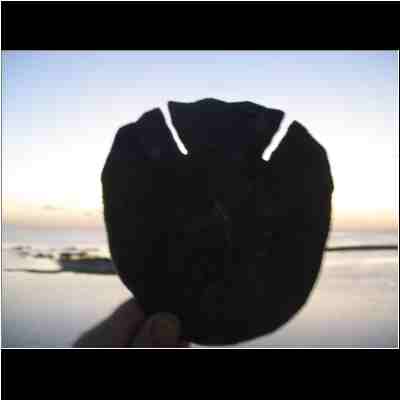Eine
Geschichte
Entdeckten Sie diese wunderschönen Muscheln an den
Küsten des ländlichen Mosambiks. Die seltene Erfahrung, entlang der
weitgehend unberührten Strände von weißer und karger Schönheit zu
wandern, die mit den Schätzen des Meeres übersät sind, die bei Flut
angeschwemmt werden und einige der Geheimnisse offenbaren, die unter dem
wilden warmen Wasser liegen, ist an sich schon magisch.
Stiefmütterchenmuscheln, Meerjungfrauenmünzen oder, wie die Amerikaner
sie wegen ihrer flachen, kreisrunden Münzform nennen, "Sand Dollars",
sind eigentlich wühlende Seeigel. Sie werden am Strand angespült und von
der afrikanischen Sonne schneeweiß gebleicht. Sie sind selten zu finden,
zerbrechlich, wenn man sie in die Hand nimmt, und dünn, wenn man sie
anfasst, ein ganz besonderer Fund.
he
Pansy Shell (Venus
verrucosa) is a type of marine mollusk found along the coastlines
of the Indian Ocean and
Atlantic Ocean,
including parts of South Africa's coastline. It is a
bivalve shell that is
often sought after by shell collectors due to its attractive appearance.
Key Features of the
Pansy Shell:
-
Appearance:
- The Pansy Shell has a
distinctive shape
with broad, rounded
edges and a large,
flattened profile.
- Its shell is typically
white to
cream-colored
and often has beautiful
purple, pink, or reddish-brown patterns that resemble
the wings of a pansy flower, which is how it got its name.
- The inner surface of the
shell is usually smooth
and shiny, often with a light iridescent sheen.
-
Habitat:
- Pansy shells are typically
found in shallow coastal
waters, especially in
rocky areas,
sandy seabeds, and areas near coral reefs.
- They are mostly found along
the shores of the
Indian Ocean and
Atlantic Ocean,
with significant populations along the coast of
South Africa,
Mozambique,
and other parts of the Indian Ocean region.
-
Size:
- These shells can grow to a
size of about 5 to 10
cm in length, with some even reaching a bit larger. The
shape and size make them quite striking when found on the beach.
-
Collecting:
- Pansy shells are often
collected for their
beauty and
unique patterns. As a result, they are commonly found
in shell shops and used in decorative art, jewelry, or simply as
collectors' items.
- However, it's important to
note that as with many marine species,
over-collection
can threaten local populations. If you're collecting shells,
it's best to follow ethical guidelines and regulations that
protect marine life and habitats.
-
Ecological Role:
- As a bivalve, the Pansy
Shell plays an important role in the ecosystem by filtering
water for plankton
and detritus,
which helps maintain water quality in the marine environment.
- They are
filter feeders,
meaning they extract small particles from the water through
their gills.
-
Conservation:
- While the Pansy Shell is
not considered endangered, its population could be impacted by
overfishing, habitat destruction, or pollution. It's important
to collect shells sustainably and protect marine environments to
help preserve these beautiful creatures.
Fun Fact:
- The Pansy Shell's
vibrant colors and
patterns are thought to help it blend into its environment,
serving as a form of
camouflage against predators in the wild.
Where to See Them:
- Pansy shells can often be
spotted on the beaches
of South Africa, especially in places like
Cape Town or the
Garden Route, and
they may be found washed up after a storm or in tidal zones. The
best time to look for them would be during
low tide when the
water has receded.
If you're a nature lover or a shell collector, the Pansy Shell is a
wonderful example of the diverse and colorful marine life found along
the South African coast. Let me know if you'd like to know more about
shell collecting or where to find them!
|
Auf der
Oberseite der Muschel befindet sich ein Symbol, das wie ein Stern
aussieht, eine Erinnerung an den Stern von Bethlehem, der die Weisen zum
Christkind führte. Um den Stern herum befindet sich der Umriss einer
Osterlilie, die an die Auferstehung des Herrn erinnert.
Ein Sanddollar hat
fünf Löcher - vier an den Enden des Sterns und eines in der Mitte. Der
religiösen Legende nach stehen die vier Löcher für die vier Wunden
Christi, als seine Hände und Füße ans Kreuz genagelt wurden. Das
mittlere Loch steht für die Wunde, die ein Soldat mit seinem Speer
verursacht hat.
Wenn man die Stiefmütterchenschale umdreht,
sieht man den Umriss eines Weihnachtssterns, der Weihnachtsblume. Und
wenn man eine Stiefmütterchenschale aufbricht, kommen fünf taubenförmige
Teile zum Vorschein. Tauben werden in Kunst und Literatur oft als Symbol
für Frieden und guten Willen verwendet.
he
Pansy Shell (Venus
verrucosa) is a type of marine mollusk found along the coastlines
of the Indian Ocean and
Atlantic Ocean,
including parts of South Africa's coastline. It is a
bivalve shell that is
often sought after by shell collectors due to its attractive appearance.
Key Features of the
Pansy Shell:
-
Appearance:
- The Pansy Shell has a
distinctive shape
with broad, rounded
edges and a large,
flattened profile.
- Its shell is typically
white to
cream-colored
and often has beautiful
purple, pink, or reddish-brown patterns that resemble
the wings of a pansy flower, which is how it got its name.
- The inner surface of the
shell is usually smooth
and shiny, often with a light iridescent sheen.
-
Habitat:
- Pansy shells are typically
found in shallow coastal
waters, especially in
rocky areas,
sandy seabeds, and areas near coral reefs.
- They are mostly found along
the shores of the
Indian Ocean and
Atlantic Ocean,
with significant populations along the coast of
South Africa,
Mozambique,
and other parts of the Indian Ocean region.
-
Size:
- These shells can grow to a
size of about 5 to 10
cm in length, with some even reaching a bit larger. The
shape and size make them quite striking when found on the beach.
-
Collecting:
- Pansy shells are often
collected for their
beauty and
unique patterns. As a result, they are commonly found
in shell shops and used in decorative art, jewelry, or simply as
collectors' items.
- However, it's important to
note that as with many marine species,
over-collection
can threaten local populations. If you're collecting shells,
it's best to follow ethical guidelines and regulations that
protect marine life and habitats.
-
Ecological Role:
- As a bivalve, the Pansy
Shell plays an important role in the ecosystem by filtering
water for plankton
and detritus,
which helps maintain water quality in the marine environment.
- They are
filter feeders,
meaning they extract small particles from the water through
their gills.
-
Conservation:
- While the Pansy Shell is
not considered endangered, its population could be impacted by
overfishing, habitat destruction, or pollution. It's important
to collect shells sustainably and protect marine environments to
help preserve these beautiful creatures.
Fun Fact:
- The Pansy Shell's
vibrant colors and
patterns are thought to help it blend into its environment,
serving as a form of
camouflage against predators in the wild.
Where to See Them:
- Pansy shells can often be
spotted on the beaches
of South Africa, especially in places like
Cape Town or the
Garden Route, and
they may be found washed up after a storm or in tidal zones. The
best time to look for them would be during
low tide when the
water has receded.
If you're a nature lover or a shell collector, the Pansy Shell is a
wonderful example of the diverse and colorful marine life found along
the South African coast. Let me know if you'd like to know more about
shell collecting or where to find them!
|
Ich würde es nicht übers Herz bringen, eine Schale aufzubrechen, um die
Tauben zu finden, aber ich finde die Geschichten, die sich um sie
ranken, ziemlich magisch. Von den Meerjungfrauen bis zu den Tauben, von
den Münzen bis zu Christus, ihre Schönheit und ihre Mystik haben die
Herzen derer erobert, die das Glück haben, eine im Sand versteckte Taube
zu finden.
Als Strandbesucher werden wir wieder eins mit
der Natur und erden uns barfuß im Sand des Naturparadieses und spüren
den Wind, den Ozean und das Meer um uns herum - man kann sich nur frei
fühlen.
he
Pansy Shell (Venus verrucosa)
is a type of marine mollusk found along the coastlines of the
Indian Ocean and
Atlantic Ocean,
including parts of South Africa's coastline. It is a
bivalve shell that is
often sought after by shell collectors due to its attractive appearance.
Key Features of the
Pansy Shell:
-
Appearance:
- The Pansy Shell has a
distinctive shape
with broad, rounded
edges and a large,
flattened profile.
- Its shell is typically
white to
cream-colored
and often has beautiful
purple, pink, or reddish-brown patterns that resemble
the wings of a pansy flower, which is how it got its name.
- The inner surface of the
shell is usually smooth
and shiny, often with a light iridescent sheen.
-
Habitat:
- Pansy shells are typically
found in shallow coastal
waters, especially in
rocky areas,
sandy seabeds, and areas near coral reefs.
- They are mostly found along
the shores of the
Indian Ocean and
Atlantic Ocean,
with significant populations along the coast of
South Africa,
Mozambique,
and other parts of the Indian Ocean region.
-
Size:
- These shells can grow to a
size of about 5 to 10
cm in length, with some even reaching a bit larger. The
shape and size make them quite striking when found on the beach.
-
Collecting:
- Pansy shells are often
collected for their
beauty and
unique patterns. As a result, they are commonly found
in shell shops and used in decorative art, jewelry, or simply as
collectors' items.
- However, it's important to
note that as with many marine species,
over-collection
can threaten local populations. If you're collecting shells,
it's best to follow ethical guidelines and regulations that
protect marine life and habitats.
-
Ecological Role:
- As a bivalve, the Pansy
Shell plays an important role in the ecosystem by filtering
water for plankton
and detritus,
which helps maintain water quality in the marine environment.
- They are
filter feeders,
meaning they extract small particles from the water through
their gills.
-
Conservation:
- While the Pansy Shell is
not considered endangered, its population could be impacted by
overfishing, habitat destruction, or pollution. It's important
to collect shells sustainably and protect marine environments to
help preserve these beautiful creatures.
Fun Fact:
- The Pansy Shell's
vibrant colors and
patterns are thought to help it blend into its environment,
serving as a form of
camouflage against predators in the wild.
Where to See Them:
- Pansy shells can often be
spotted on the beaches
of South Africa, especially in places like
Cape Town or the
Garden Route, and
they may be found washed up after a storm or in tidal zones. The
best time to look for them would be during
low tide when the
water has receded.
If you're a nature lover or a shell collector, the Pansy Shell is a
wonderful example of the diverse and colorful marine life found along
the South African coast. Let me know if you'd like to know more about
shell collecting or where to find them!
|
 Safaris
Bergsteigen
Wandern
Inselwandern Weltweit
Safaris
Bergsteigen
Wandern
Inselwandern Weltweit
 Europa
Inselwandern
Europa
Inselwandern
 Städtewandern
Städtewandern
 Paintings
Paintings Dirk Rauschenbach
Dirk Rauschenbach
 Safaris
Bergsteigen
Wandern
Inselwandern Weltweit
Safaris
Bergsteigen
Wandern
Inselwandern Weltweit
 Europa
Inselwandern
Europa
Inselwandern
 Städtewandern
Städtewandern
 Paintings
Paintings Dirk Rauschenbach
Dirk Rauschenbach




![]() 26.07.25 Copyright Dirk
Rauschenbach Koelnerstrasse 293 51702 Bergneustadt
Datenschutzerklaerung 02261 9788972 Mail ccooly(
at) web.de
26.07.25 Copyright Dirk
Rauschenbach Koelnerstrasse 293 51702 Bergneustadt
Datenschutzerklaerung 02261 9788972 Mail ccooly(
at) web.de